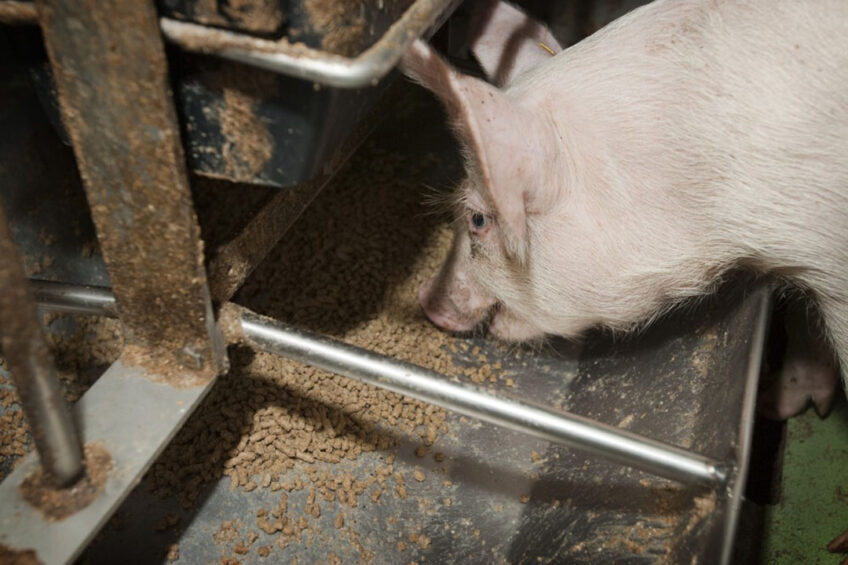Understanding mechanisms of gene-nutrient interaction in pigs

In this article, we consider the impact of individual pig genetic make-up in response to a specific dietary pattern and the influence of nutrient intake on gene expression.
Intramuscular fat or marbling is an important pork sensory quality affecting consumer preference and premiums for pork. As a result, enhancing the marbling quality of pork is of major interest to swine nutritionists, breeders and geneticists for health and economic reasons.
Several factors, such as the genetic make-up of the pig, sex, age, dietary micronutrients and environmental conditions, impact fat metabolism and phenotypic response in pigs. In addition, recent studies have found that fat metabolism and marbling are regulated by several genes directly or indirectly involved in fatty acid metabolism, cell proliferation and differentiation.
Nutrigenetics and nutrigenomics are 2 different scientific fields that provide a general approach to understanding the complex mechanisms of gene-nutrient interaction and the environment of the entire genome.
Nutrigenetics vs nutrigenomics
Nutrigenetics and nutrigenomics are 2 distinct terms that are often confused. ‘Nutri’ (or nutrient) refers to the chemical compounds in a diet required for cellular functions. Genetics is the study of individual genes, whereas genomics is the study of the entire genome which is the entirety of an organism’s genes, their interactions and how they are affected by the environment.
Nutrigenetics studies the impact of individual differences at genetic level in response to a specific dietary pattern, functional food or supplement on a specific health outcome; while nutrigenomics evaluates the influence of nutrient intake on gene expression and related molecular and biological events thereafter.
Impact of genetic make-up on response to nutrient intake
Most fat metabolism-related genes indirectly influence the intramuscular fat content of pork. However, their effects have shown variability with regard to muscle location and mechanisms of fat synthesis.
Intramuscular fat content and meat quality traits differ between pig breeds due to various expressions of the genes and enzymes involved in fatty acid synthesis and fat metabolism. Various studies have reported the following genes as associated with fat metabolism and intramuscular fat content in pig breeds.
• PPAR genes
Mainly PPARα and PPARγ which are associated with the metabolic pathways related to fat metabolism. Higher concentrations of PPARα are found mainly in organs such as the liver, while PPARγ is more concentrated in the fat tissues.
• FABP
Primarily A-FABP and H-FABP which are involved in fat metabolism and carry out intracellular transport of fatty acids from the cell membrane to sites of fatty acid oxidation.
• SCD gene
SCD is a functional gene associated with the fatty acid composition of porcine and acts as an important regulator of the genetic mechanism of fat deposition and fatty acid synthesis.
• LEP gene
Porcine leptin is involved in feed intake and energy homeostasis and impacts the rate of intramuscular fat accretion.
• ACACA and FASN genes
Both of these genes regulate the synthesis of fatty acids and their level of expression varies between pig breeds.
• MSTN or GDF8 gene
This gene is responsible for double muscling in Belgian domestic pig breeds.
• SREBF-1 gene
This gene has a critical role in the gene transcription mechanism and regulation of muscle fat deposition.
Impact of dietary nutrient supply on gene expression
Protein, amino acids, fat and micro/macro-nutrient supplementation are applied during different growth and developmental stages of pigs. Dietary protein levels have a regulatory mechanism on gene expression related to fat metabolism. A high dietary protein supply at 18% significantly reduces mRNA expression, enzyme activity and expression levels of fat and marbling genes in pigs. In addition, amino acids such as methionine, lysine, histidine, isoleucine, leucine, phenylalanine, threonine, tryptophan and valine are essential in several metabolic pathways and gene expression.
Altering the level of dietary lysine can have a huge nutrigenetic impact on pigs. A low supply of lysine in the diet of heavy finishing pigs promotes intramuscular fat deposition and better marbling. Studies showed that a 0.78% lysine supply results in higher intramuscular content in growing pigs. Micronutrients influence the expression pattern of several genes and modulate the signaling pathways of genes and their regulatory elements during growth and development. Additionally, dietary fatty acids have a vital regulatory effect on DNA receptors and enzymes during DNA transcription and translation.
To round up
The scientific fields of nutrigenetics and nutrigenomics are effective and precise in describing changes in gene sequences that predispose individual pig breeds to respond in a certain way in terms of health, performance and meat quality.
Based on the principles of nutrigenetics and nutrigenomics, the complex mechanisms of gene-nutrient interaction and the environmental effect on the entire genome can be explained. This then makes it possible to measure nutritional effects with the aim of fine-tuning gene expressions and regulating genome responses in pigs, to optimise growth performance, backfat thickness, intramuscular deposition, disease resistance and meat quality traits.
However, given the wide variability in pig genetics, environment and the quality and quantity of the nutrients in any diet, establishing the individual effect of all nutrients on gene responses remains challenging. This means that further research is required to be able to integrate the scientific principles of nutrigenetics and nutrigenomics as a tool in swine nutrition and feeding.











